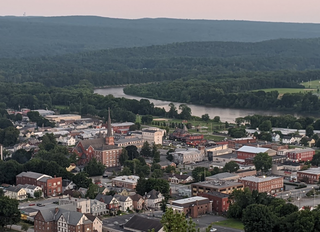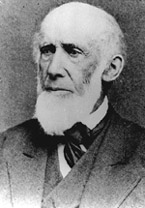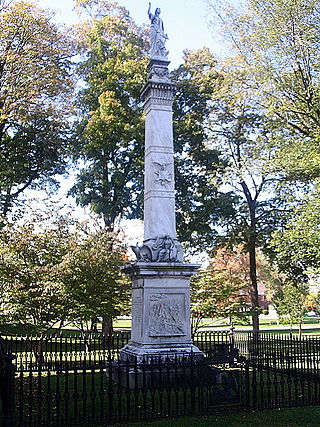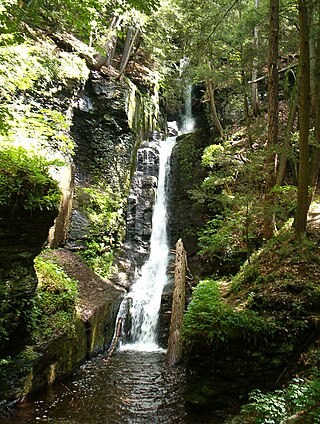
Orange County is a county located in the U.S. state of New York. As of the 2020 census, the population was 401,310. The county seat is Goshen. This county was first created in 1683 and reorganized with its present boundaries in 1798.

Port Jervis is a city located at the confluence of the Neversink and Delaware rivers in western Orange County, New York, United States, north of the Delaware Water Gap. Its population was 8,775 at the 2020 census. The communities of Deerpark, Huguenot, Sparrowbush, and Greenville are adjacent to Port Jervis. Matamoras, Pennsylvania, is across the river and connected by the Mid-Delaware Bridge. Montague Township, New Jersey, also borders the city. The Tri-States Monument, marking the tripoint between New York, New Jersey, and Pennsylvania, lies at the southwestern corner of the city.

Fort Mifflin, originally called Fort Island Battery and also known as Mud Island Fort, was commissioned in 1771 and sits on Mud Island on the Delaware River below Philadelphia, Pennsylvania near Philadelphia International Airport.

John Bloomfield Jervis was an American civil engineer. America's leading consulting engineer of the antebellum era (1820–60), Jervis designed and supervised the construction of five of America's earliest railroads, was chief engineer of three major canal projects, designed the famous, pioneering, DeWitt Clinton steam locomotive in 1831 while with the Mohawk & Hudson RR, designed the first locomotive with a swiveling 4-wheeled front bogie truck in 1832 for the M&H RR, designed and built the 41-mile Croton Aqueduct – New York City's fresh water supply from 1842 to 1891 – and was a consulting engineer for the Boston water system.

The Battle of Minisink was a battle of the American Revolutionary War fought at Minisink Ford, New York, on July 22, 1779. It was the only major skirmish of the Revolutionary War fought in the upper Delaware valley. The battle was a decisive British victory, as the Patriot militia was hastily assembled, ill-equipped and inexperienced.

New York State Route 97 (NY 97) is a 70.53-mile-long (113.51 km) north–south scenic route in southern New York in the United States. It runs from U.S. Route 6 (US 6) and US 209 in Port Jervis to NY 17 in Hancock. Its most famous feature is the Hawk's Nest, a tightly winding section of the road along the Delaware River, located a few miles north of Port Jervis. NY 97 intersects NY 52 in Narrowsburg and indirectly connects to three Pennsylvania state highways due to its proximity to the state line.

The Delaware and Hudson Canal was the first venture of the Delaware and Hudson Canal Company, which would later build the Delaware and Hudson Railway. Between 1828 and 1899, the canal's barges carried anthracite coal from the mines of northeastern Pennsylvania to the Hudson River and thence to market in New York City.
Minisink Ford is a hamlet on the Delaware River, fifteen miles northwest of Port Jervis. It is in the town of Highland, Sullivan County, New York, United States.

Delaware Water Gap National Recreation Area is a 70,000-acre (28,000 ha) national recreation area administered by the National Park Service in northwest New Jersey and northeast Pennsylvania. It is centered around a 40-mile (64 km) stretch of the Delaware River designated the Middle Delaware National Scenic River. At the area's southern end lays the Delaware Water Gap, a dramatic mountain pass where the river cuts between Blue Mountain and Kittatinny Mountain.
Old Mine Road is a road in New Jersey and New York said to be one of the oldest continuously used roads in the United States of America. At a length of 104 miles (167 km), it stretches from the Delaware Water Gap National Recreation Area to the vicinity of Kingston, New York.

Rondout, is situated in Ulster County, New York on the Hudson River at the mouth of Rondout Creek. Originally a maritime village, the arrival of the Delaware and Hudson Canal helped create a city that dwarfed nearby Kingston. Rondout would become the third largest port on the Hudson River. Rondout merged with Kingston in 1872. It now includes the Rondout-West Strand Historic District.

Barryville is a hamlet in Highland, Sullivan County, New York, United States. Previously known as "The River," the hamlet was renamed for William T. Barry, postmaster general under President Andrew Jackson.

The Port Jervis station is a disused train station at the corner of Jersey Avenue and Fowler Street in Port Jervis, New York. It was built in 1892 as a passenger station for the Erie Railroad by Grattan & Jennings in the Queen Anne style. For years it was the busiest passenger station on the railroad's Delaware Branch because Port Jervis is along the Delaware River near the tripoint of New York, New Jersey, and Pennsylvania. The long-distance passenger trains Erie Limited and the Lake Cities between Chicago and Hoboken served this station.

Bellevue State Park is a 328-acre (133 ha) Delaware state park in the suburbs of Wilmington in New Castle County, Delaware in the United States. The park is named for Bellevue Hall, the former mansion of William du Pont Jr. Many of the facilities at the park were built by du Pont. Bellevue State Park overlooks the Delaware River and is open for year-round recreation, daily, from 8 a.m. until sunset. The Mount Pleasant Methodist Episcopal Church and Parsonage is located in Bellevue State Park; it was added to the National Register of Historic Places in 1998. Cauffiel House is a historic home in the park near Stoney Creek.
Historic preservation in New York is activity undertaken to conserve forests, buildings, ships, sacred Indian burial grounds, water purity and other objects of cultural importance in New York in ways that allow them to communicate meaningfully about past practices, events, and people. Governmental programs for historic preservation range from Federal ownership and active operation of sites to grants and subsidies provided by state government, municipal support of museums and interpretative displays. Nonprofit programs include activities of statewide and local historical associations and museums, and activities of historical societies and museums at the national level. Quasi-governmental organizations, such as the New York State Thruway Authority and Thousand Islands Bridge Authority, play a role as well. Private endeavors, such as investment and other choices made by private landowners to conserve historical features of their properties, are significant but less visible and include groups such as the Historic Districts Council, The New York Landmarks Conservancy and the Preservation League of New York State. During the reconstruction of the World Trade Center site in July 2010, a team of archaeologists discovered a 32-foot-long boat. The craft was at least 200 years old, dating from a time when the Hudson River was partly filled with trash and debris because of a rapidly expanding lower Manhattan.

The Snyder Estate Natural Cement Historic District is located in the Town of Rosendale, New York, United States. It is a 275-acre (111 ha) tract roughly bounded by Rondout Creek, Binnewater and Cottekill roads and Sawdust Avenue. NY 213 runs through the lower portion of the district, paralleling the dry bed of the Delaware and Hudson Canal.

Hurley is a hamlet in the Town of Hurley, Ulster County, New York, United States. The population was 3,346 at the 2020 census.

The Minisink or Minisink Valley is a loosely defined geographic region of the Upper Delaware River valley in northwestern New Jersey, northeastern Pennsylvania and New York.

Van Campen's Inn or Isaac Van Campen Inn is a fieldstone residence that was used as a yaugh house during the American colonial era. Located in Walpack Township, Sussex County, New Jersey along the Delaware River, it is a historic site located along the Old Mine Road in the Delaware Water Gap National Recreation Area. It is operated under a memorandum of understanding between the National Park Service and the Walpack Historical Society, a local non-profit corporation.

Wallpack Valley is a valley located in Sussex County in northwestern New Jersey formed by Wallpack Ridge on the west, and Kittatinny Mountain on the east. Wallpack Ridge separates the Wallpack Valley from the valley of the Delaware River, and contains the watershed of the Flat Brook and its main tributaries Big Flat Brook and Little Flat Brook. It is a narrow valley, roughly 25 miles (40 km) in length running from Montague Township south of Port Jervis, New York to the Walpack Bend in the Delaware River near Flatbrookville in Walpack Township where the Flat Brook enters the Delaware at 300 feet above sea level.



















